Comprehensive Financial Report: Accounting for Business Decisions
VerifiedAdded on 2023/06/08
|13
|2110
|469
Report
AI Summary
This report provides a detailed analysis of accounting for business decisions, covering various aspects such as bank reconciliation, inventory management using the FIFO method, and depreciation calculations. It includes the preparation of a bank reconciliation statement for Energy Boost, journal entries for specific transactions, and the calculation of ending inventory and cost of sales using the FIFO costing method. The report also differentiates between perpetual and periodic inventory systems and addresses the recording of equipment purchases, accumulated depreciation using both straight-line and diminishing balance methods, and the sale of machinery. Furthermore, it presents adjusting entries at the end of the accounting period and discusses closing entries, contrasting the treatment in a sole proprietorship versus a company structure. This document is available on Desklib, which provides a platform for students to access solved assignments and past papers.
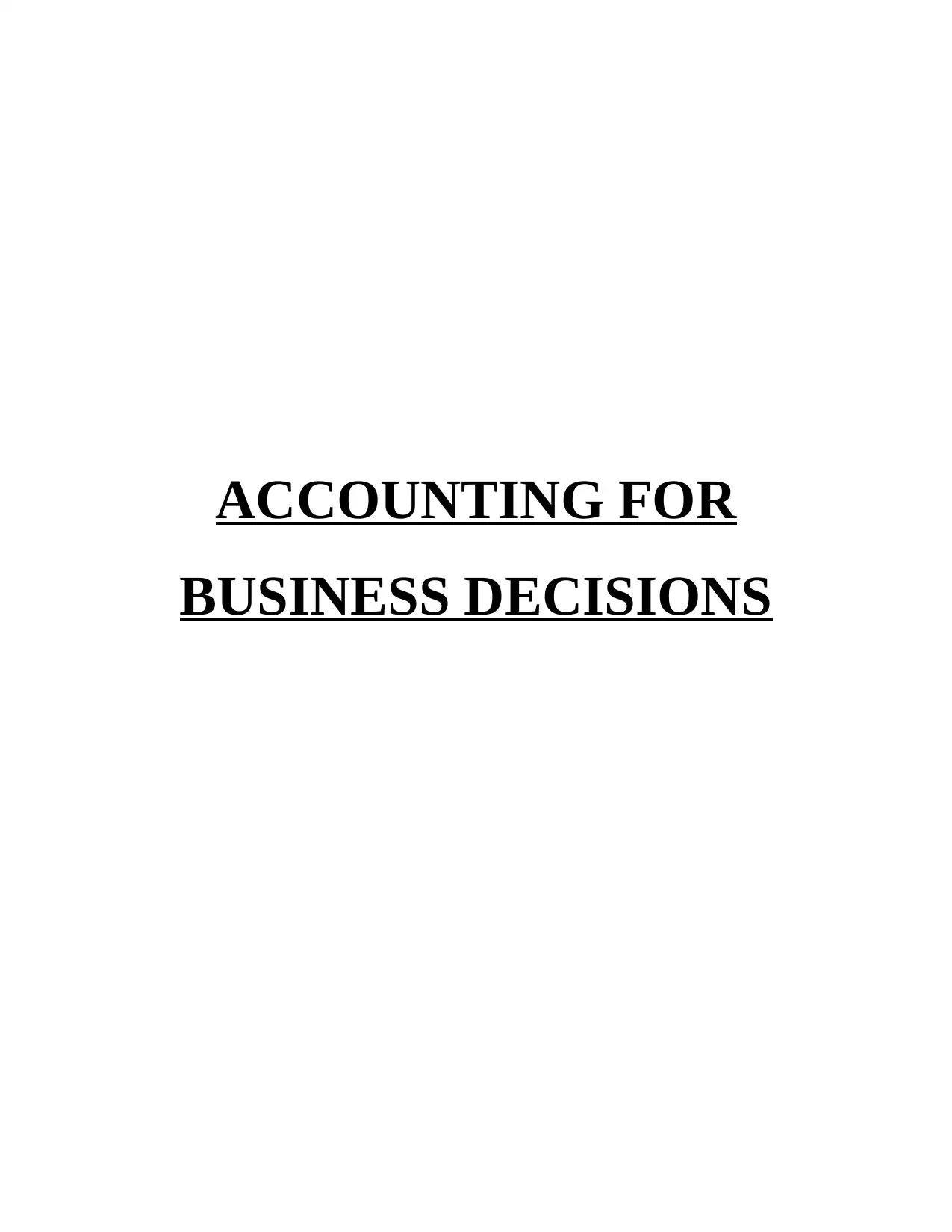
ACCOUNTING FOR
BUSINESS DECISIONS
BUSINESS DECISIONS
Paraphrase This Document
Need a fresh take? Get an instant paraphrase of this document with our AI Paraphraser
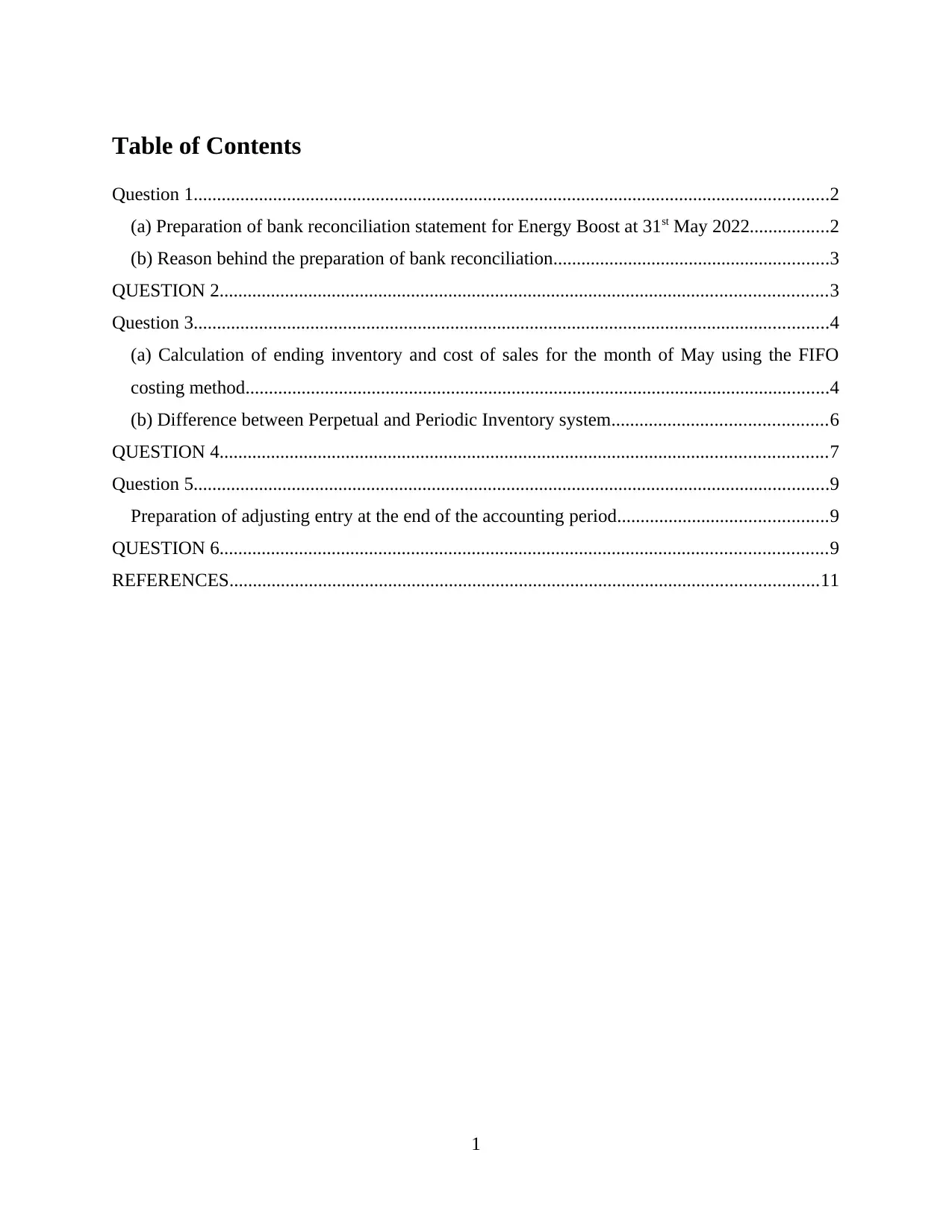
Table of Contents
Question 1........................................................................................................................................2
(a) Preparation of bank reconciliation statement for Energy Boost at 31st May 2022.................2
(b) Reason behind the preparation of bank reconciliation...........................................................3
QUESTION 2..................................................................................................................................3
Question 3........................................................................................................................................4
(a) Calculation of ending inventory and cost of sales for the month of May using the FIFO
costing method.............................................................................................................................4
(b) Difference between Perpetual and Periodic Inventory system..............................................6
QUESTION 4..................................................................................................................................7
Question 5........................................................................................................................................9
Preparation of adjusting entry at the end of the accounting period.............................................9
QUESTION 6..................................................................................................................................9
REFERENCES..............................................................................................................................11
1
Question 1........................................................................................................................................2
(a) Preparation of bank reconciliation statement for Energy Boost at 31st May 2022.................2
(b) Reason behind the preparation of bank reconciliation...........................................................3
QUESTION 2..................................................................................................................................3
Question 3........................................................................................................................................4
(a) Calculation of ending inventory and cost of sales for the month of May using the FIFO
costing method.............................................................................................................................4
(b) Difference between Perpetual and Periodic Inventory system..............................................6
QUESTION 4..................................................................................................................................7
Question 5........................................................................................................................................9
Preparation of adjusting entry at the end of the accounting period.............................................9
QUESTION 6..................................................................................................................................9
REFERENCES..............................................................................................................................11
1
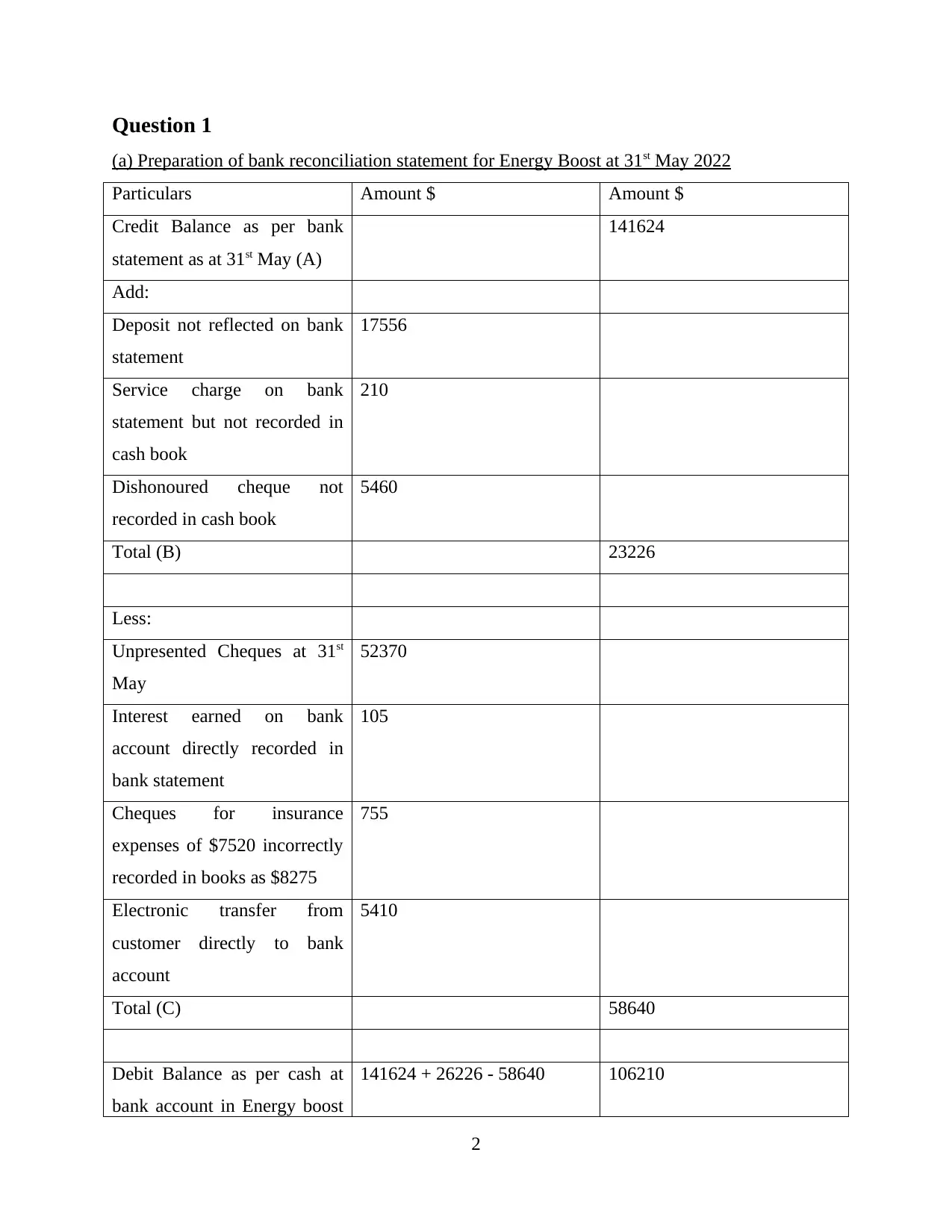
Question 1
(a) Preparation of bank reconciliation statement for Energy Boost at 31st May 2022
Particulars Amount $ Amount $
Credit Balance as per bank
statement as at 31st May (A)
141624
Add:
Deposit not reflected on bank
statement
17556
Service charge on bank
statement but not recorded in
cash book
210
Dishonoured cheque not
recorded in cash book
5460
Total (B) 23226
Less:
Unpresented Cheques at 31st
May
52370
Interest earned on bank
account directly recorded in
bank statement
105
Cheques for insurance
expenses of $7520 incorrectly
recorded in books as $8275
755
Electronic transfer from
customer directly to bank
account
5410
Total (C) 58640
Debit Balance as per cash at
bank account in Energy boost
141624 + 26226 - 58640 106210
2
(a) Preparation of bank reconciliation statement for Energy Boost at 31st May 2022
Particulars Amount $ Amount $
Credit Balance as per bank
statement as at 31st May (A)
141624
Add:
Deposit not reflected on bank
statement
17556
Service charge on bank
statement but not recorded in
cash book
210
Dishonoured cheque not
recorded in cash book
5460
Total (B) 23226
Less:
Unpresented Cheques at 31st
May
52370
Interest earned on bank
account directly recorded in
bank statement
105
Cheques for insurance
expenses of $7520 incorrectly
recorded in books as $8275
755
Electronic transfer from
customer directly to bank
account
5410
Total (C) 58640
Debit Balance as per cash at
bank account in Energy boost
141624 + 26226 - 58640 106210
2
⊘ This is a preview!⊘
Do you want full access?
Subscribe today to unlock all pages.

Trusted by 1+ million students worldwide
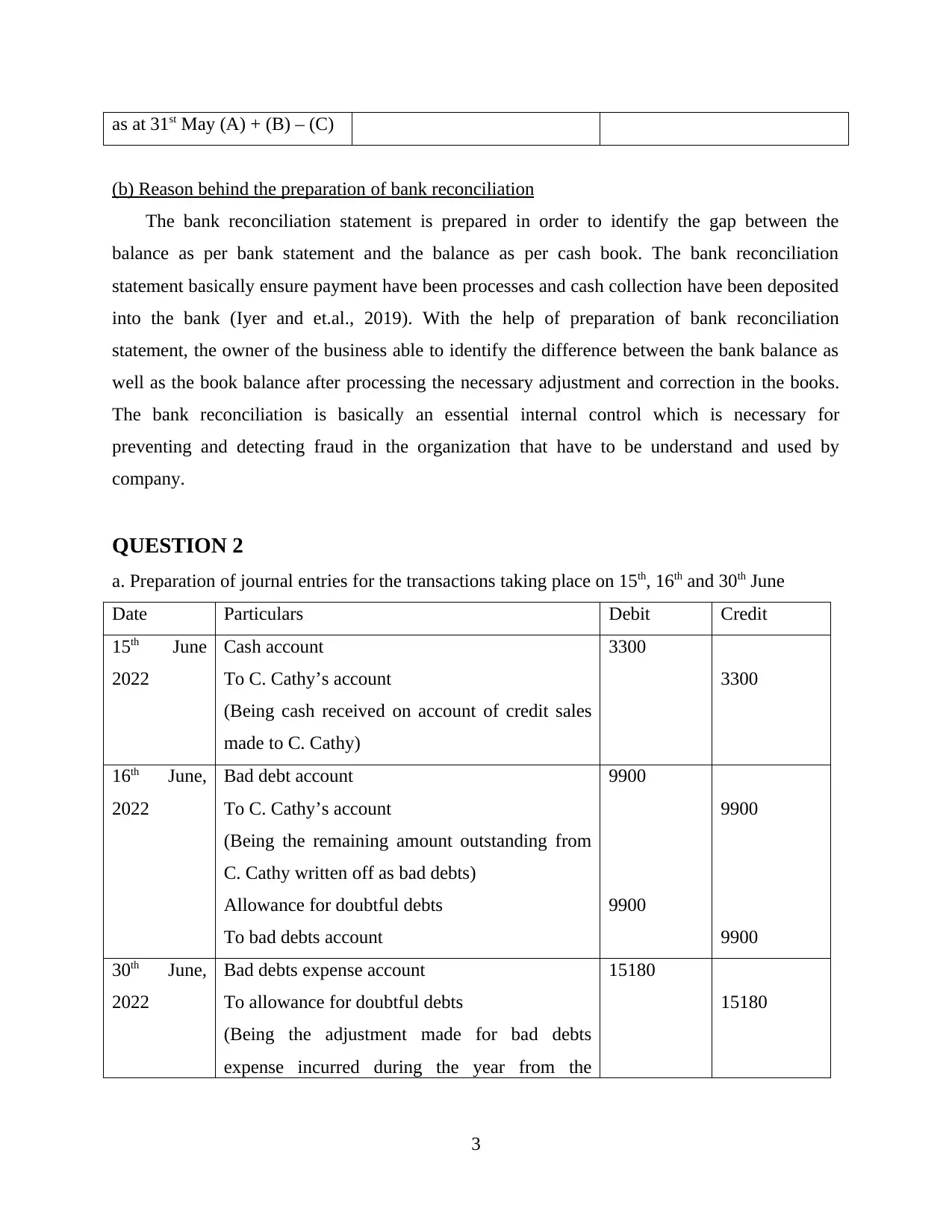
as at 31st May (A) + (B) – (C)
(b) Reason behind the preparation of bank reconciliation
The bank reconciliation statement is prepared in order to identify the gap between the
balance as per bank statement and the balance as per cash book. The bank reconciliation
statement basically ensure payment have been processes and cash collection have been deposited
into the bank (Iyer and et.al., 2019). With the help of preparation of bank reconciliation
statement, the owner of the business able to identify the difference between the bank balance as
well as the book balance after processing the necessary adjustment and correction in the books.
The bank reconciliation is basically an essential internal control which is necessary for
preventing and detecting fraud in the organization that have to be understand and used by
company.
QUESTION 2
a. Preparation of journal entries for the transactions taking place on 15th, 16th and 30th June
Date Particulars Debit Credit
15th June
2022
Cash account
To C. Cathy’s account
(Being cash received on account of credit sales
made to C. Cathy)
3300
3300
16th June,
2022
Bad debt account
To C. Cathy’s account
(Being the remaining amount outstanding from
C. Cathy written off as bad debts)
Allowance for doubtful debts
To bad debts account
9900
9900
9900
9900
30th June,
2022
Bad debts expense account
To allowance for doubtful debts
(Being the adjustment made for bad debts
expense incurred during the year from the
15180
15180
3
(b) Reason behind the preparation of bank reconciliation
The bank reconciliation statement is prepared in order to identify the gap between the
balance as per bank statement and the balance as per cash book. The bank reconciliation
statement basically ensure payment have been processes and cash collection have been deposited
into the bank (Iyer and et.al., 2019). With the help of preparation of bank reconciliation
statement, the owner of the business able to identify the difference between the bank balance as
well as the book balance after processing the necessary adjustment and correction in the books.
The bank reconciliation is basically an essential internal control which is necessary for
preventing and detecting fraud in the organization that have to be understand and used by
company.
QUESTION 2
a. Preparation of journal entries for the transactions taking place on 15th, 16th and 30th June
Date Particulars Debit Credit
15th June
2022
Cash account
To C. Cathy’s account
(Being cash received on account of credit sales
made to C. Cathy)
3300
3300
16th June,
2022
Bad debt account
To C. Cathy’s account
(Being the remaining amount outstanding from
C. Cathy written off as bad debts)
Allowance for doubtful debts
To bad debts account
9900
9900
9900
9900
30th June,
2022
Bad debts expense account
To allowance for doubtful debts
(Being the adjustment made for bad debts
expense incurred during the year from the
15180
15180
3
Paraphrase This Document
Need a fresh take? Get an instant paraphrase of this document with our AI Paraphraser
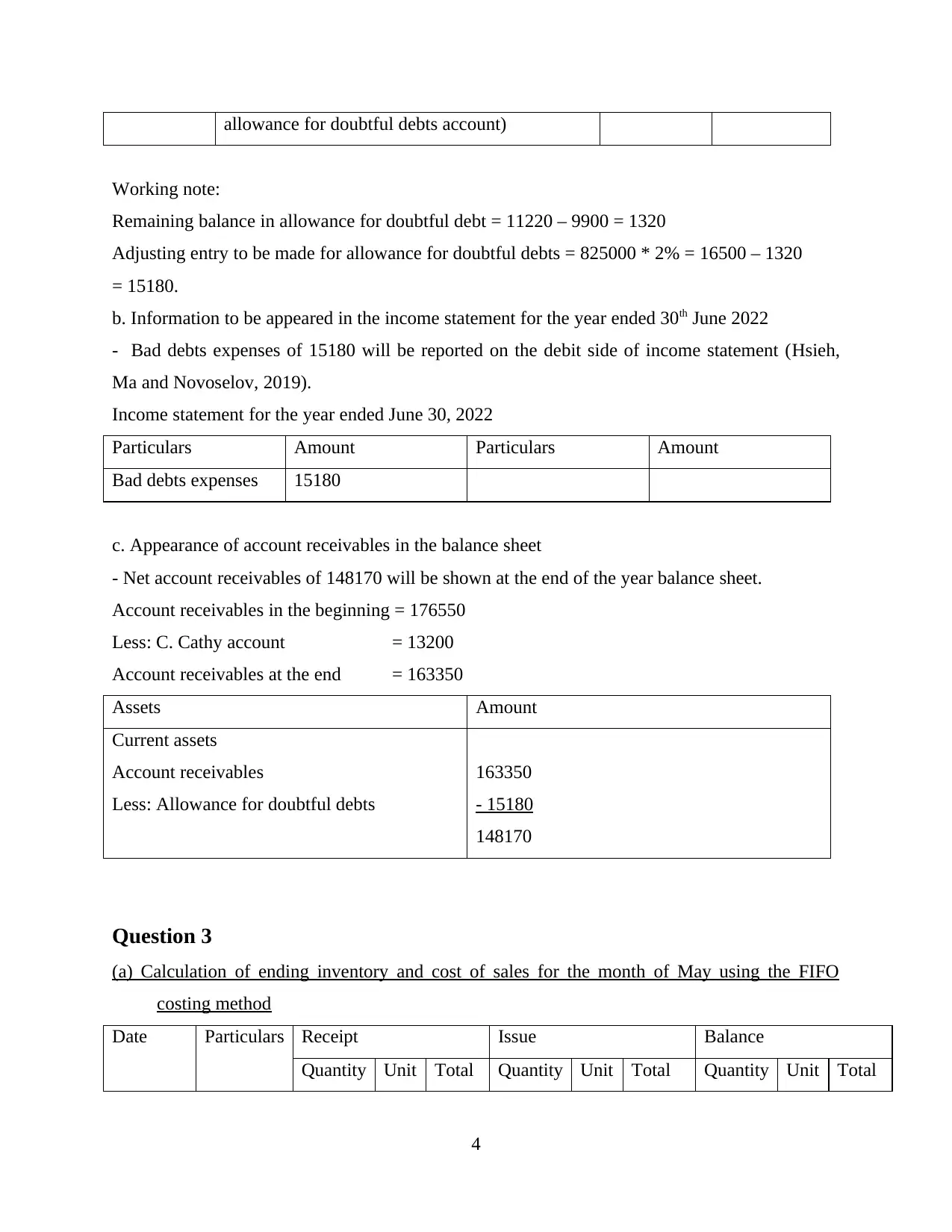
allowance for doubtful debts account)
Working note:
Remaining balance in allowance for doubtful debt = 11220 – 9900 = 1320
Adjusting entry to be made for allowance for doubtful debts = 825000 * 2% = 16500 – 1320
= 15180.
b. Information to be appeared in the income statement for the year ended 30th June 2022
- Bad debts expenses of 15180 will be reported on the debit side of income statement (Hsieh,
Ma and Novoselov, 2019).
Income statement for the year ended June 30, 2022
Particulars Amount Particulars Amount
Bad debts expenses 15180
c. Appearance of account receivables in the balance sheet
- Net account receivables of 148170 will be shown at the end of the year balance sheet.
Account receivables in the beginning = 176550
Less: C. Cathy account = 13200
Account receivables at the end = 163350
Assets Amount
Current assets
Account receivables
Less: Allowance for doubtful debts
163350
- 15180
148170
Question 3
(a) Calculation of ending inventory and cost of sales for the month of May using the FIFO
costing method
Date Particulars Receipt Issue Balance
Quantity Unit Total Quantity Unit Total Quantity Unit Total
4
Working note:
Remaining balance in allowance for doubtful debt = 11220 – 9900 = 1320
Adjusting entry to be made for allowance for doubtful debts = 825000 * 2% = 16500 – 1320
= 15180.
b. Information to be appeared in the income statement for the year ended 30th June 2022
- Bad debts expenses of 15180 will be reported on the debit side of income statement (Hsieh,
Ma and Novoselov, 2019).
Income statement for the year ended June 30, 2022
Particulars Amount Particulars Amount
Bad debts expenses 15180
c. Appearance of account receivables in the balance sheet
- Net account receivables of 148170 will be shown at the end of the year balance sheet.
Account receivables in the beginning = 176550
Less: C. Cathy account = 13200
Account receivables at the end = 163350
Assets Amount
Current assets
Account receivables
Less: Allowance for doubtful debts
163350
- 15180
148170
Question 3
(a) Calculation of ending inventory and cost of sales for the month of May using the FIFO
costing method
Date Particulars Receipt Issue Balance
Quantity Unit Total Quantity Unit Total Quantity Unit Total
4
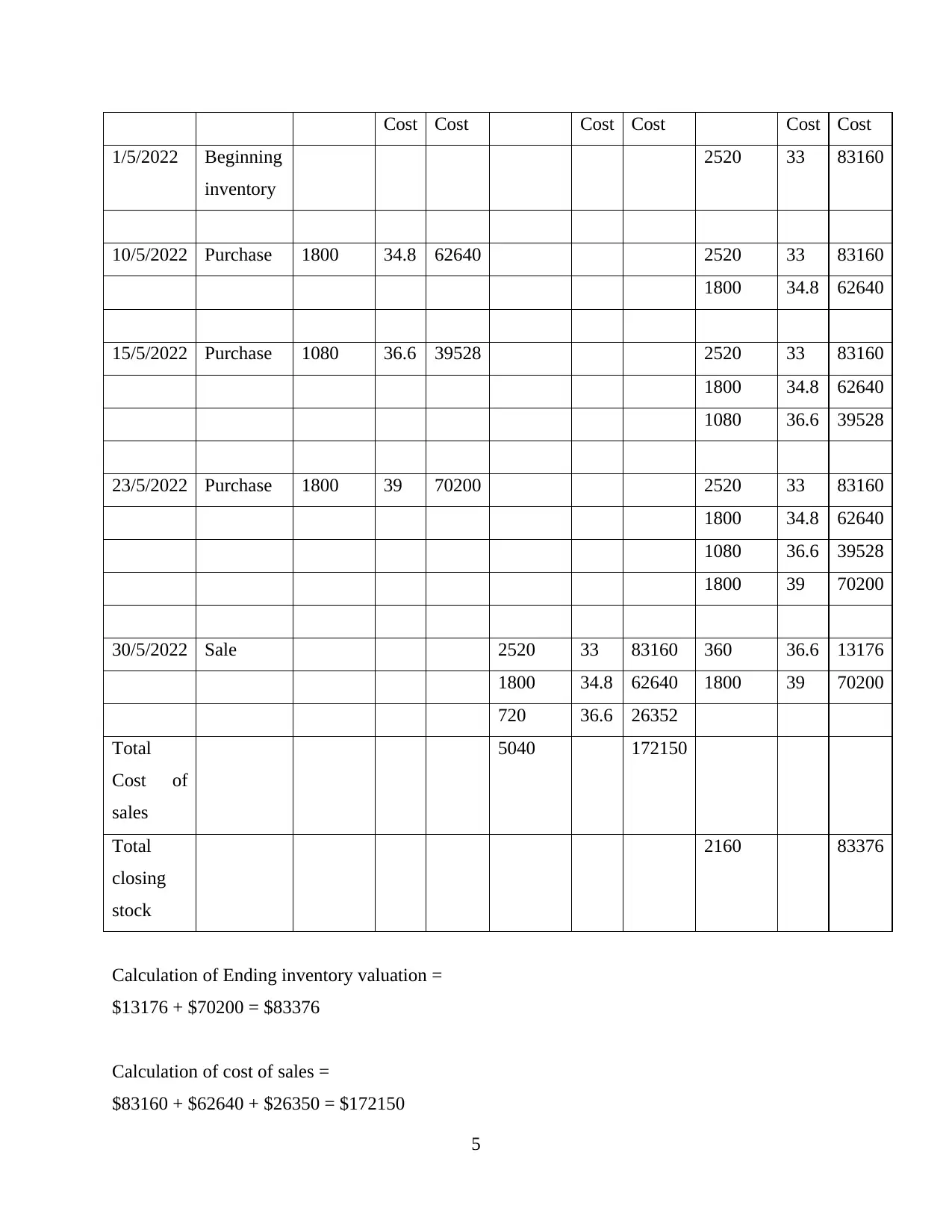
Cost Cost Cost Cost Cost Cost
1/5/2022 Beginning
inventory
2520 33 83160
10/5/2022 Purchase 1800 34.8 62640 2520 33 83160
1800 34.8 62640
15/5/2022 Purchase 1080 36.6 39528 2520 33 83160
1800 34.8 62640
1080 36.6 39528
23/5/2022 Purchase 1800 39 70200 2520 33 83160
1800 34.8 62640
1080 36.6 39528
1800 39 70200
30/5/2022 Sale 2520 33 83160 360 36.6 13176
1800 34.8 62640 1800 39 70200
720 36.6 26352
Total
Cost of
sales
5040 172150
Total
closing
stock
2160 83376
Calculation of Ending inventory valuation =
$13176 + $70200 = $83376
Calculation of cost of sales =
$83160 + $62640 + $26350 = $172150
5
1/5/2022 Beginning
inventory
2520 33 83160
10/5/2022 Purchase 1800 34.8 62640 2520 33 83160
1800 34.8 62640
15/5/2022 Purchase 1080 36.6 39528 2520 33 83160
1800 34.8 62640
1080 36.6 39528
23/5/2022 Purchase 1800 39 70200 2520 33 83160
1800 34.8 62640
1080 36.6 39528
1800 39 70200
30/5/2022 Sale 2520 33 83160 360 36.6 13176
1800 34.8 62640 1800 39 70200
720 36.6 26352
Total
Cost of
sales
5040 172150
Total
closing
stock
2160 83376
Calculation of Ending inventory valuation =
$13176 + $70200 = $83376
Calculation of cost of sales =
$83160 + $62640 + $26350 = $172150
5
⊘ This is a preview!⊘
Do you want full access?
Subscribe today to unlock all pages.

Trusted by 1+ million students worldwide
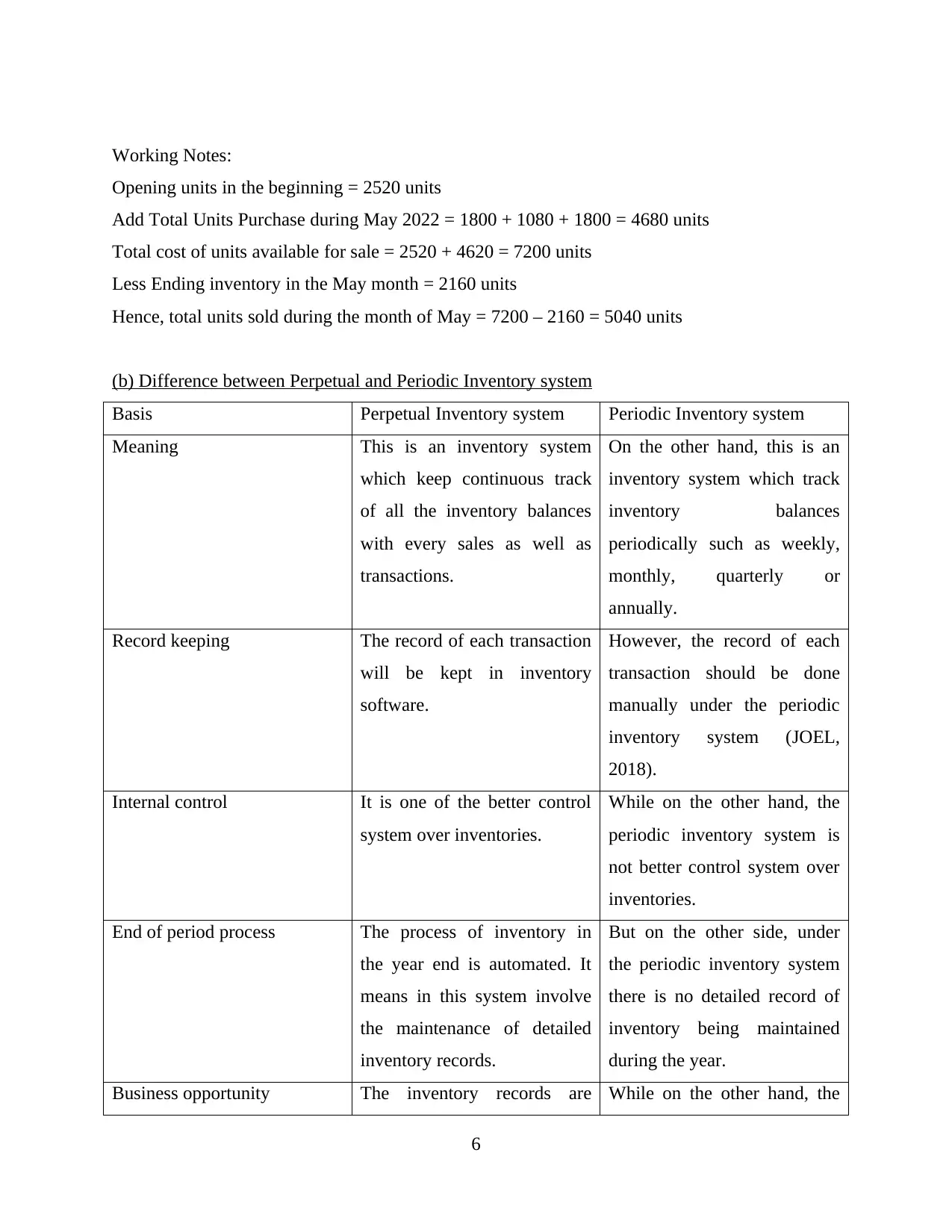
Working Notes:
Opening units in the beginning = 2520 units
Add Total Units Purchase during May 2022 = 1800 + 1080 + 1800 = 4680 units
Total cost of units available for sale = 2520 + 4620 = 7200 units
Less Ending inventory in the May month = 2160 units
Hence, total units sold during the month of May = 7200 – 2160 = 5040 units
(b) Difference between Perpetual and Periodic Inventory system
Basis Perpetual Inventory system Periodic Inventory system
Meaning This is an inventory system
which keep continuous track
of all the inventory balances
with every sales as well as
transactions.
On the other hand, this is an
inventory system which track
inventory balances
periodically such as weekly,
monthly, quarterly or
annually.
Record keeping The record of each transaction
will be kept in inventory
software.
However, the record of each
transaction should be done
manually under the periodic
inventory system (JOEL,
2018).
Internal control It is one of the better control
system over inventories.
While on the other hand, the
periodic inventory system is
not better control system over
inventories.
End of period process The process of inventory in
the year end is automated. It
means in this system involve
the maintenance of detailed
inventory records.
But on the other side, under
the periodic inventory system
there is no detailed record of
inventory being maintained
during the year.
Business opportunity The inventory records are While on the other hand, the
6
Opening units in the beginning = 2520 units
Add Total Units Purchase during May 2022 = 1800 + 1080 + 1800 = 4680 units
Total cost of units available for sale = 2520 + 4620 = 7200 units
Less Ending inventory in the May month = 2160 units
Hence, total units sold during the month of May = 7200 – 2160 = 5040 units
(b) Difference between Perpetual and Periodic Inventory system
Basis Perpetual Inventory system Periodic Inventory system
Meaning This is an inventory system
which keep continuous track
of all the inventory balances
with every sales as well as
transactions.
On the other hand, this is an
inventory system which track
inventory balances
periodically such as weekly,
monthly, quarterly or
annually.
Record keeping The record of each transaction
will be kept in inventory
software.
However, the record of each
transaction should be done
manually under the periodic
inventory system (JOEL,
2018).
Internal control It is one of the better control
system over inventories.
While on the other hand, the
periodic inventory system is
not better control system over
inventories.
End of period process The process of inventory in
the year end is automated. It
means in this system involve
the maintenance of detailed
inventory records.
But on the other side, under
the periodic inventory system
there is no detailed record of
inventory being maintained
during the year.
Business opportunity The inventory records are While on the other hand, the
6
Paraphrase This Document
Need a fresh take? Get an instant paraphrase of this document with our AI Paraphraser
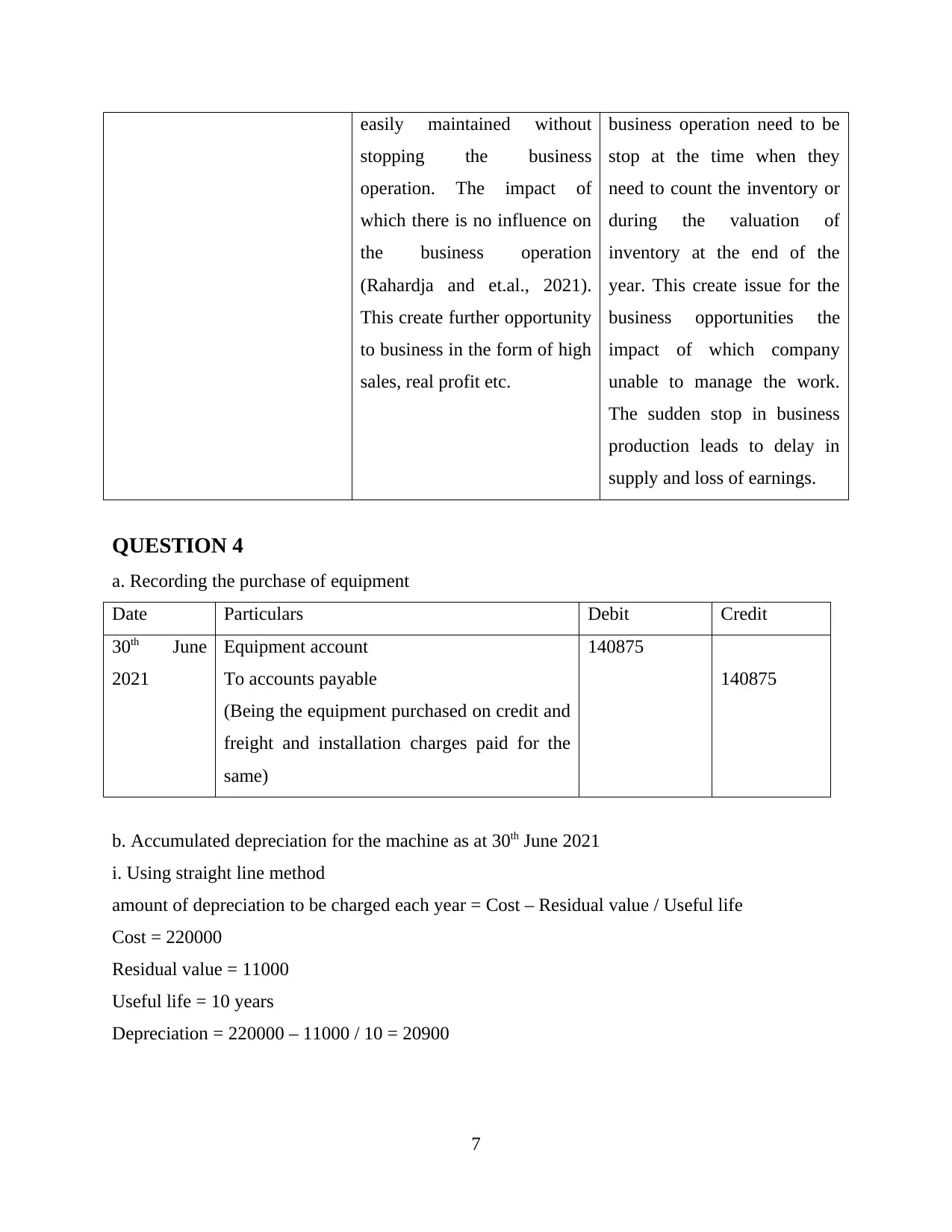
easily maintained without
stopping the business
operation. The impact of
which there is no influence on
the business operation
(Rahardja and et.al., 2021).
This create further opportunity
to business in the form of high
sales, real profit etc.
business operation need to be
stop at the time when they
need to count the inventory or
during the valuation of
inventory at the end of the
year. This create issue for the
business opportunities the
impact of which company
unable to manage the work.
The sudden stop in business
production leads to delay in
supply and loss of earnings.
QUESTION 4
a. Recording the purchase of equipment
Date Particulars Debit Credit
30th June
2021
Equipment account
To accounts payable
(Being the equipment purchased on credit and
freight and installation charges paid for the
same)
140875
140875
b. Accumulated depreciation for the machine as at 30th June 2021
i. Using straight line method
amount of depreciation to be charged each year = Cost – Residual value / Useful life
Cost = 220000
Residual value = 11000
Useful life = 10 years
Depreciation = 220000 – 11000 / 10 = 20900
7
stopping the business
operation. The impact of
which there is no influence on
the business operation
(Rahardja and et.al., 2021).
This create further opportunity
to business in the form of high
sales, real profit etc.
business operation need to be
stop at the time when they
need to count the inventory or
during the valuation of
inventory at the end of the
year. This create issue for the
business opportunities the
impact of which company
unable to manage the work.
The sudden stop in business
production leads to delay in
supply and loss of earnings.
QUESTION 4
a. Recording the purchase of equipment
Date Particulars Debit Credit
30th June
2021
Equipment account
To accounts payable
(Being the equipment purchased on credit and
freight and installation charges paid for the
same)
140875
140875
b. Accumulated depreciation for the machine as at 30th June 2021
i. Using straight line method
amount of depreciation to be charged each year = Cost – Residual value / Useful life
Cost = 220000
Residual value = 11000
Useful life = 10 years
Depreciation = 220000 – 11000 / 10 = 20900
7
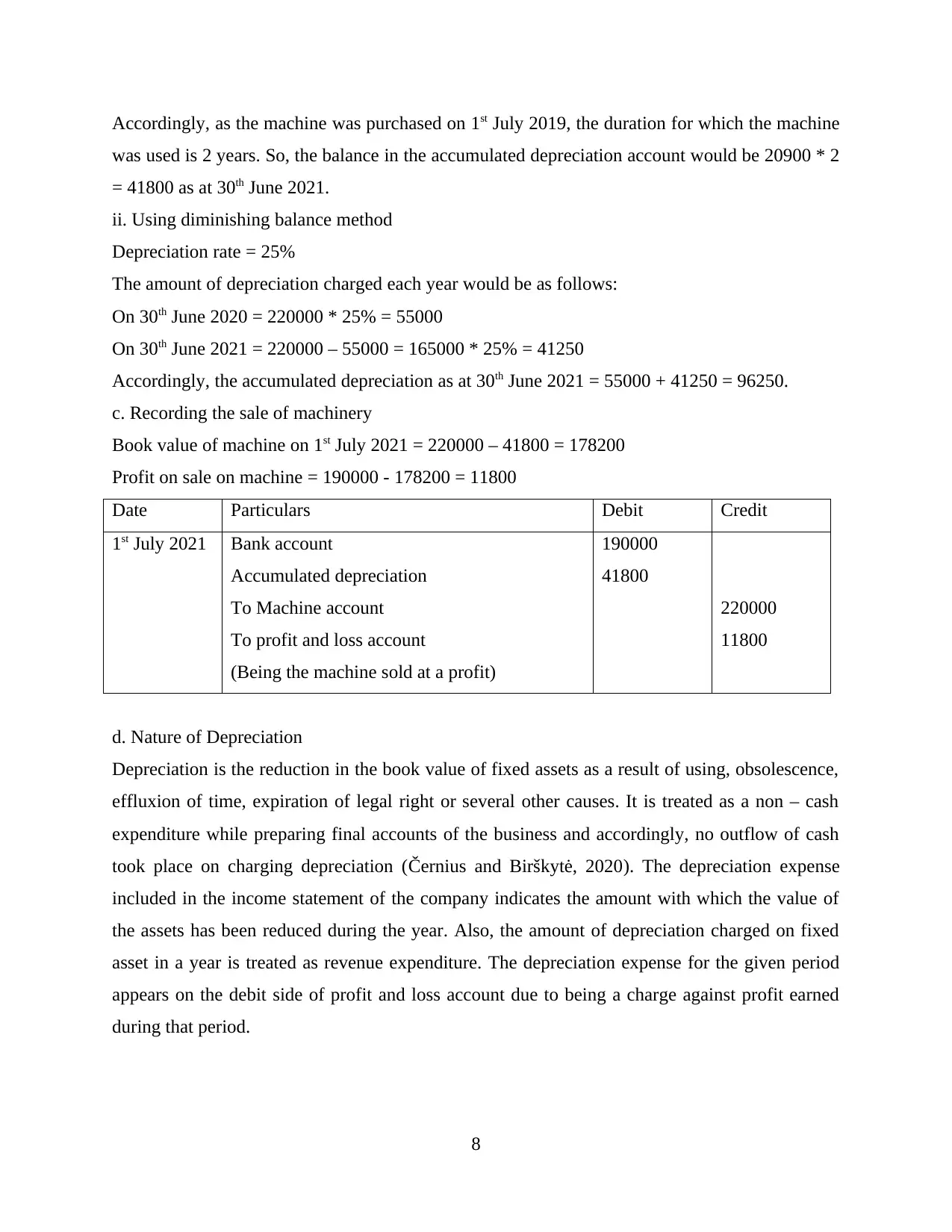
Accordingly, as the machine was purchased on 1st July 2019, the duration for which the machine
was used is 2 years. So, the balance in the accumulated depreciation account would be 20900 * 2
= 41800 as at 30th June 2021.
ii. Using diminishing balance method
Depreciation rate = 25%
The amount of depreciation charged each year would be as follows:
On 30th June 2020 = 220000 * 25% = 55000
On 30th June 2021 = 220000 – 55000 = 165000 * 25% = 41250
Accordingly, the accumulated depreciation as at 30th June 2021 = 55000 + 41250 = 96250.
c. Recording the sale of machinery
Book value of machine on 1st July 2021 = 220000 – 41800 = 178200
Profit on sale on machine = 190000 - 178200 = 11800
Date Particulars Debit Credit
1st July 2021 Bank account
Accumulated depreciation
To Machine account
To profit and loss account
(Being the machine sold at a profit)
190000
41800
220000
11800
d. Nature of Depreciation
Depreciation is the reduction in the book value of fixed assets as a result of using, obsolescence,
effluxion of time, expiration of legal right or several other causes. It is treated as a non – cash
expenditure while preparing final accounts of the business and accordingly, no outflow of cash
took place on charging depreciation (Černius and Birškytė, 2020). The depreciation expense
included in the income statement of the company indicates the amount with which the value of
the assets has been reduced during the year. Also, the amount of depreciation charged on fixed
asset in a year is treated as revenue expenditure. The depreciation expense for the given period
appears on the debit side of profit and loss account due to being a charge against profit earned
during that period.
8
was used is 2 years. So, the balance in the accumulated depreciation account would be 20900 * 2
= 41800 as at 30th June 2021.
ii. Using diminishing balance method
Depreciation rate = 25%
The amount of depreciation charged each year would be as follows:
On 30th June 2020 = 220000 * 25% = 55000
On 30th June 2021 = 220000 – 55000 = 165000 * 25% = 41250
Accordingly, the accumulated depreciation as at 30th June 2021 = 55000 + 41250 = 96250.
c. Recording the sale of machinery
Book value of machine on 1st July 2021 = 220000 – 41800 = 178200
Profit on sale on machine = 190000 - 178200 = 11800
Date Particulars Debit Credit
1st July 2021 Bank account
Accumulated depreciation
To Machine account
To profit and loss account
(Being the machine sold at a profit)
190000
41800
220000
11800
d. Nature of Depreciation
Depreciation is the reduction in the book value of fixed assets as a result of using, obsolescence,
effluxion of time, expiration of legal right or several other causes. It is treated as a non – cash
expenditure while preparing final accounts of the business and accordingly, no outflow of cash
took place on charging depreciation (Černius and Birškytė, 2020). The depreciation expense
included in the income statement of the company indicates the amount with which the value of
the assets has been reduced during the year. Also, the amount of depreciation charged on fixed
asset in a year is treated as revenue expenditure. The depreciation expense for the given period
appears on the debit side of profit and loss account due to being a charge against profit earned
during that period.
8
⊘ This is a preview!⊘
Do you want full access?
Subscribe today to unlock all pages.

Trusted by 1+ million students worldwide
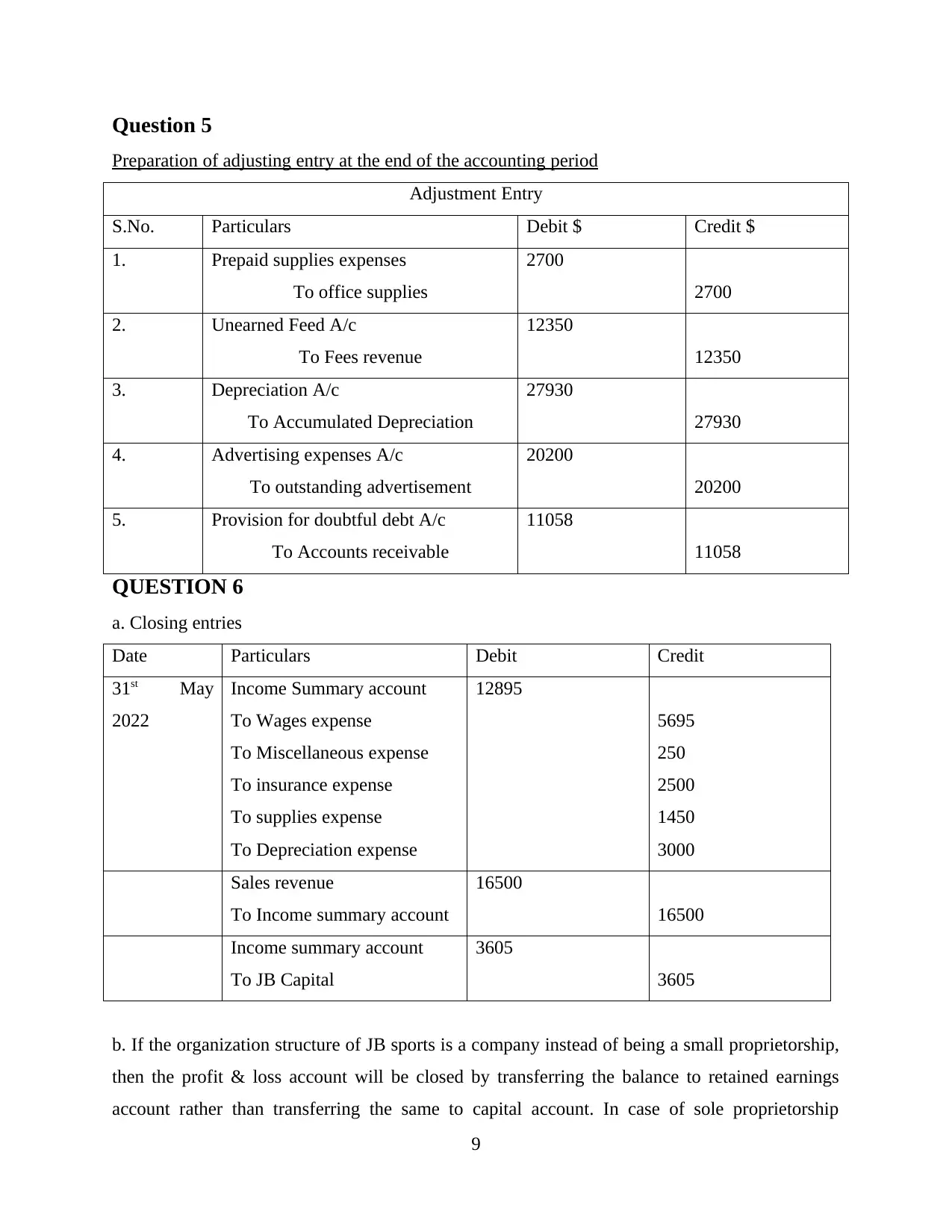
Question 5
Preparation of adjusting entry at the end of the accounting period
Adjustment Entry
S.No. Particulars Debit $ Credit $
1. Prepaid supplies expenses
To office supplies
2700
2700
2. Unearned Feed A/c
To Fees revenue
12350
12350
3. Depreciation A/c
To Accumulated Depreciation
27930
27930
4. Advertising expenses A/c
To outstanding advertisement
20200
20200
5. Provision for doubtful debt A/c
To Accounts receivable
11058
11058
QUESTION 6
a. Closing entries
Date Particulars Debit Credit
31st May
2022
Income Summary account
To Wages expense
To Miscellaneous expense
To insurance expense
To supplies expense
To Depreciation expense
12895
5695
250
2500
1450
3000
Sales revenue
To Income summary account
16500
16500
Income summary account
To JB Capital
3605
3605
b. If the organization structure of JB sports is a company instead of being a small proprietorship,
then the profit & loss account will be closed by transferring the balance to retained earnings
account rather than transferring the same to capital account. In case of sole proprietorship
9
Preparation of adjusting entry at the end of the accounting period
Adjustment Entry
S.No. Particulars Debit $ Credit $
1. Prepaid supplies expenses
To office supplies
2700
2700
2. Unearned Feed A/c
To Fees revenue
12350
12350
3. Depreciation A/c
To Accumulated Depreciation
27930
27930
4. Advertising expenses A/c
To outstanding advertisement
20200
20200
5. Provision for doubtful debt A/c
To Accounts receivable
11058
11058
QUESTION 6
a. Closing entries
Date Particulars Debit Credit
31st May
2022
Income Summary account
To Wages expense
To Miscellaneous expense
To insurance expense
To supplies expense
To Depreciation expense
12895
5695
250
2500
1450
3000
Sales revenue
To Income summary account
16500
16500
Income summary account
To JB Capital
3605
3605
b. If the organization structure of JB sports is a company instead of being a small proprietorship,
then the profit & loss account will be closed by transferring the balance to retained earnings
account rather than transferring the same to capital account. In case of sole proprietorship
9
Paraphrase This Document
Need a fresh take? Get an instant paraphrase of this document with our AI Paraphraser
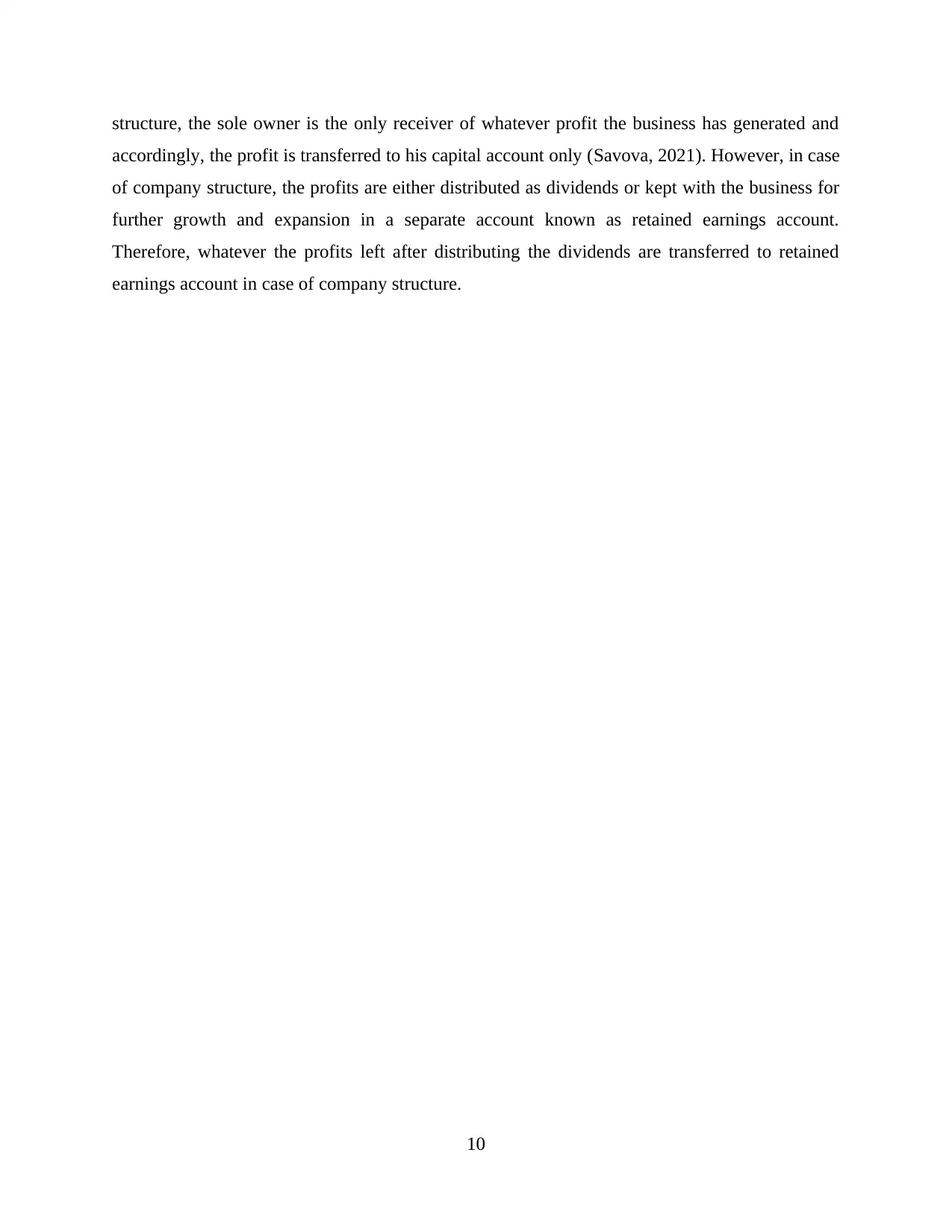
structure, the sole owner is the only receiver of whatever profit the business has generated and
accordingly, the profit is transferred to his capital account only (Savova, 2021). However, in case
of company structure, the profits are either distributed as dividends or kept with the business for
further growth and expansion in a separate account known as retained earnings account.
Therefore, whatever the profits left after distributing the dividends are transferred to retained
earnings account in case of company structure.
10
accordingly, the profit is transferred to his capital account only (Savova, 2021). However, in case
of company structure, the profits are either distributed as dividends or kept with the business for
further growth and expansion in a separate account known as retained earnings account.
Therefore, whatever the profits left after distributing the dividends are transferred to retained
earnings account in case of company structure.
10
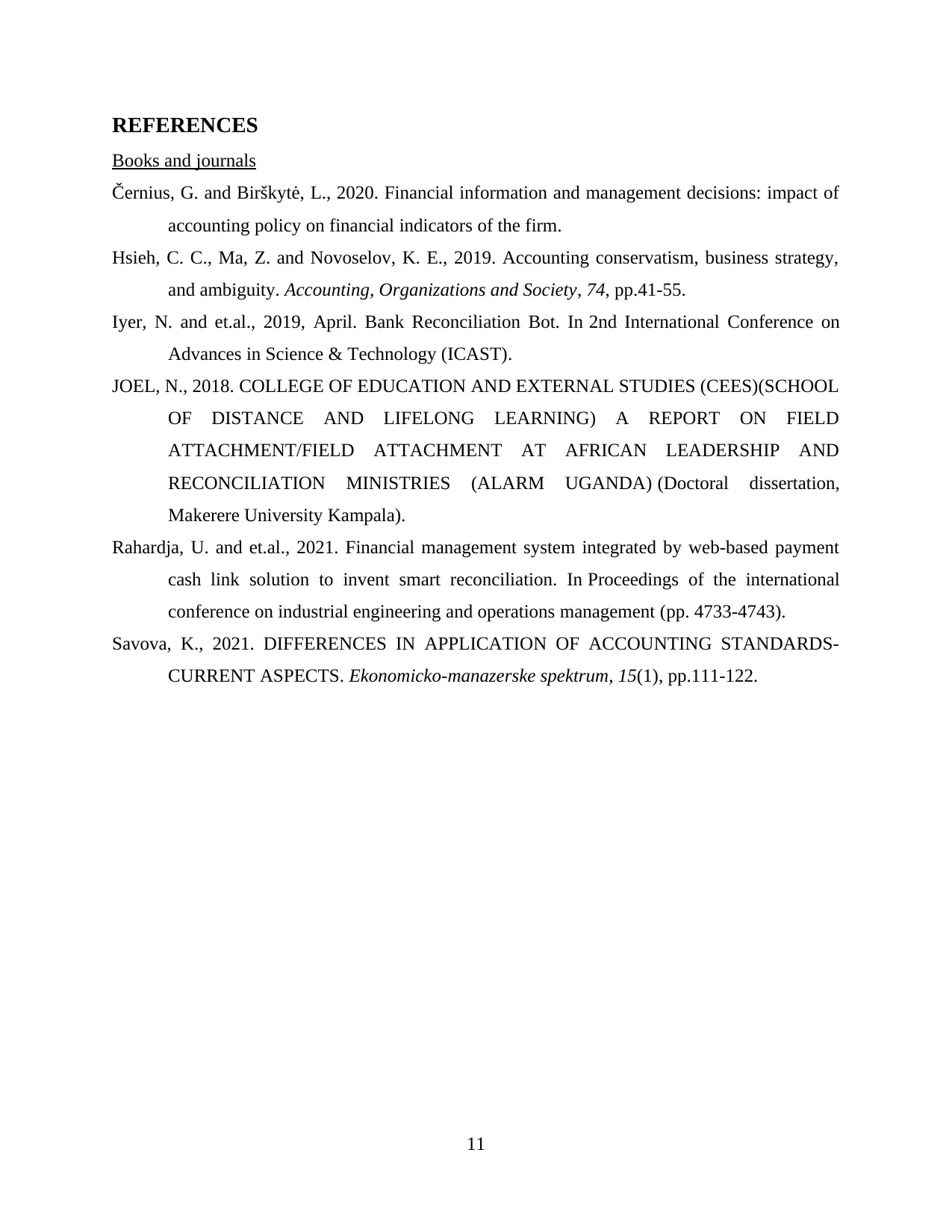
REFERENCES
Books and journals
Černius, G. and Birškytė, L., 2020. Financial information and management decisions: impact of
accounting policy on financial indicators of the firm.
Hsieh, C. C., Ma, Z. and Novoselov, K. E., 2019. Accounting conservatism, business strategy,
and ambiguity. Accounting, Organizations and Society, 74, pp.41-55.
Iyer, N. and et.al., 2019, April. Bank Reconciliation Bot. In 2nd International Conference on
Advances in Science & Technology (ICAST).
JOEL, N., 2018. COLLEGE OF EDUCATION AND EXTERNAL STUDIES (CEES)(SCHOOL
OF DISTANCE AND LIFELONG LEARNING) A REPORT ON FIELD
ATTACHMENT/FIELD ATTACHMENT AT AFRICAN LEADERSHIP AND
RECONCILIATION MINISTRIES (ALARM UGANDA) (Doctoral dissertation,
Makerere University Kampala).
Rahardja, U. and et.al., 2021. Financial management system integrated by web-based payment
cash link solution to invent smart reconciliation. In Proceedings of the international
conference on industrial engineering and operations management (pp. 4733-4743).
Savova, K., 2021. DIFFERENCES IN APPLICATION OF ACCOUNTING STANDARDS-
CURRENT ASPECTS. Ekonomicko-manazerske spektrum, 15(1), pp.111-122.
11
Books and journals
Černius, G. and Birškytė, L., 2020. Financial information and management decisions: impact of
accounting policy on financial indicators of the firm.
Hsieh, C. C., Ma, Z. and Novoselov, K. E., 2019. Accounting conservatism, business strategy,
and ambiguity. Accounting, Organizations and Society, 74, pp.41-55.
Iyer, N. and et.al., 2019, April. Bank Reconciliation Bot. In 2nd International Conference on
Advances in Science & Technology (ICAST).
JOEL, N., 2018. COLLEGE OF EDUCATION AND EXTERNAL STUDIES (CEES)(SCHOOL
OF DISTANCE AND LIFELONG LEARNING) A REPORT ON FIELD
ATTACHMENT/FIELD ATTACHMENT AT AFRICAN LEADERSHIP AND
RECONCILIATION MINISTRIES (ALARM UGANDA) (Doctoral dissertation,
Makerere University Kampala).
Rahardja, U. and et.al., 2021. Financial management system integrated by web-based payment
cash link solution to invent smart reconciliation. In Proceedings of the international
conference on industrial engineering and operations management (pp. 4733-4743).
Savova, K., 2021. DIFFERENCES IN APPLICATION OF ACCOUNTING STANDARDS-
CURRENT ASPECTS. Ekonomicko-manazerske spektrum, 15(1), pp.111-122.
11
⊘ This is a preview!⊘
Do you want full access?
Subscribe today to unlock all pages.

Trusted by 1+ million students worldwide
1 out of 13
Related Documents
Your All-in-One AI-Powered Toolkit for Academic Success.
+13062052269
info@desklib.com
Available 24*7 on WhatsApp / Email
![[object Object]](/_next/static/media/star-bottom.7253800d.svg)
Unlock your academic potential
Copyright © 2020–2025 A2Z Services. All Rights Reserved. Developed and managed by ZUCOL.



